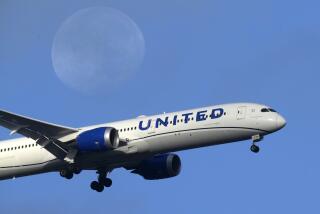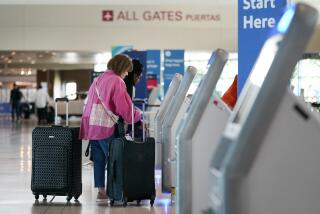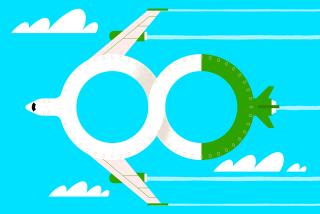Breaking the Code of Airline Code-Sharing
- Share via
By now, you’ve probably encountered the name game that’s raging in the airports of North America and around the world: You make a booking on Airline No. 1, yet find yourself actually traveling on Airline No. 2. Will Airline No. 1 and Airline No. 2 swap your frequent-flier credits when you ask them to, or award them in the same way? Or maintain matching policies to cover smoking and carry-on baggage?
Probably. Perhaps. Possibly.
The airline industry term for this is “code-sharing,” and though alliances are constantly shifting, it now seems clear that as long as they’re allowed to, airlines will keep this practice in their strategic arsenal. Two dramatic examples of this are a proposed pact between American Airlines and British Airways, and last month’s unveiling of the “Star Alliance,” a code-share agreement among United, Lufthansa, Air Canada, SAS, Thai Airways and Varig airlines. Passengers who fail to study up on such deals stand a good chance of being confused or disappointed.
In code-sharing arrangements, an airline agrees to list another airline’s flights as its own, sell tickets for them and share revenues. Thus, Airline No. 1’s Flight 100 may turn out to be the same plane, on the same itinerary, at the same time, as Airline No. 2’s Flight 200. By doing this, airlines can create the impression that they fly to more places, more often, than they really do.
Does code-sharing do consumers any good? Yes. It allows carriers to coordinate departure times (thereby reducing airport waits), smooths the seat-assignment process and eases baggage transfers. It allows travelers who book their own flights to reserve a two-carrier itinerary with a single call and a single billing.
Unfortunately, to master the code-share game, a consumer has to confront a welter of subtle corporate alliances that no ordinary civilian can fully grasp.
How to survive in such circumstances? Here are some potential code-sharing snafus to avoid:
* You book a trip--especially one that involves changing planes in a second city on the way to your ultimate destination--and you neglect to ask if it’s a code-share. Whether you’re booking through a travel agent or directly through the carrier, you should always specifically ask if a code-share is involved, because even though most agents and reservationists are instructed to advise you of that, it doesn’t always happen. In some code-share cases, the arrangement simply means that though you bought your nonstop ticket from United, the plane you board will say Lufthansa. In other cases, you buy tickets for a trip that involves connecting, and find that the second flight is being operated by a different carrier.
* You bypass deals offered by foreign carriers and decide to pay a little more in order to use a familiar U.S. carrier and its code-share partner for a trip overseas, reasoning that a familiar company may be easier to deal with if something goes wrong. But once at your destination, there’s a high probability that the U.S.-based carrier will be utterly invisible, leaving you to deal with the personnel of its code-share partner. In other words, a foreign carrier.
* Informed that you’ll be traveling on a code-share flight, you trust your travel agent or the airline reservationist to pass along your frequent-flier number and make sure you’ll get credit for every segment of your journey. But that’s no guarantee that your credits will automatically accumulate. Travelers need to specifically double-check at the airport gate. Otherwise, you could have to dig up a boarding pass and try to negotiate a correction by mail after the fact. (Keep in mind, too, that code-share partners also can vary in the minimum mileage awards for flights--500 miles instead of 250, for instance--and in their connections with partners’ “elite” program for very frequent fliers.
* You assume that you can use your Airline 1 frequent-flier program credits to book seats on any flight code-shared under the name of Airline 1. Usually, yes. But that’s overlooking an important distinction: Not all code-share partners are mileage program partners too. When booking a code-shared flight, always ask if the airlines involved have a mileage agreement that works both ways--for accumulating, and cashing in.
* You’re flying coach on a code-share flight to Asia, which will cramp your body and throw your internal clock out of whack, but at least, you figure, you’re racking up lots of mileage. Maybe not. For instance, American and Delta’s mileage programs usually give credits no matter where you sit in the plane. And both of those carriers have code-share and mileage agreements with Singapore Airlines. But Singapore gives mileage credits only to those in business and first classes. Coach customers on Singapore’s planes, whether they’ve booked through Singapore or Delta or American, get no miles. (As I found out by calling, even some airline reservationists are unaware of this pitfall.)
* You’re highly sensitive to cigarette smoke, so you make it a point to book your overseas flight on a U.S. carrier that bans smoking. Or you’re determined to carry aboard two heavy bags that are dangerously close to your regular carrier’s carry-on limit. But is it a code-shared flight? If it is, you have another question or two to ask, because code-sharers, especially those based overseas, may have different policies than your familiar U.S. carrier.
Reynolds travels anonymously at the newspaper’s expense, accepting no special discounts or subsidized trips. He welcomes comments and suggestions, but cannot respond individually to letters and calls. Write Travel Insider, Los Angeles Times, Times Mirror Square, Los Angeles 90053 or e-mail [email protected].
More to Read
Sign up for The Wild
We’ll help you find the best places to hike, bike and run, as well as the perfect silent spots for meditation and yoga.
You may occasionally receive promotional content from the Los Angeles Times.







